For quite a long period of time, steel reinforcement has been the leading position. Now, for about 30 years, in the construction of buildings, preference has been given to such an exceptional building material as fiberglass reinforcement (CA). It optimally combines strength, long-term operation, the ability to endure heavy loads without subsequent destruction.
Its significant advantage is its unlimited length. The practicality of use in comparison with metal is manifested in connection with the negative parameters of the latter, namely, the tendency to corrosion, contact with acids and alkalis, and difficulties in installation. All these shortcomings were taken into account and new unique properties were created.
Advantages and disadvantages of plastic fittings
Pros of CA:
- ... resistance is increased up to 3-3.5 times;
- ... lightweight by 3-4 times;
- ... reduction of costs for reinforcement from 30% and more;
- ... thermal expansion eliminates the formation of cracks if the structure is heated;
- ... resistance to low temperatures while maintaining working resources;
- ... significant exploitation term (about 80 years);
- ... chemical passivity, manifested in resistance to corrosion and communication with an aggressive environment;
- ... non-toxicity;
- ... good processing;
- ... ease and simplicity during transportation, installation work due to the use of lightweight fittings;
- ... non-conductive pyroelectric;
- ... radio transparency, magnetic inertness.
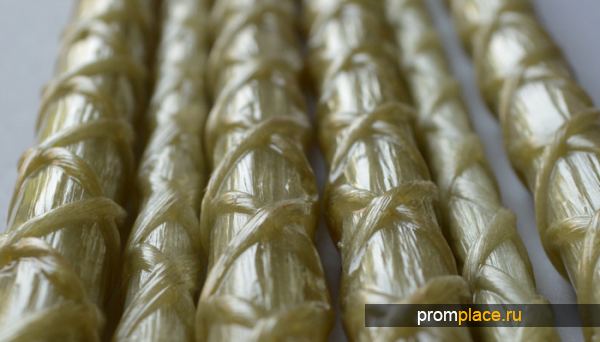
Cons of CA:
- . low level elasticity;
- ... deterioration of properties at temperatures above 200 ° C due to softening of the polymer that holds the fibers together;
- ... lack of GOST in production (for this period, technical specifications have been developed)
- ... insufficient prevalence.
Production of fiberglass structures
Fiberglass reinforcement has been in production for about 50 years. It is made from glass containing quartz and inorganic materials. The glass is tempered at 1300… 1600 ° C. This processing method affects internal communications - they break, lose continuity, structurally modify due to the appearance of oxides.
Fibers are formed by stretching and quenching the molten material. It comes in a filament structure from a large number clearly calibrated holes in a heated platinum alloy die. The temperature of the glass extrusion die must be stable.
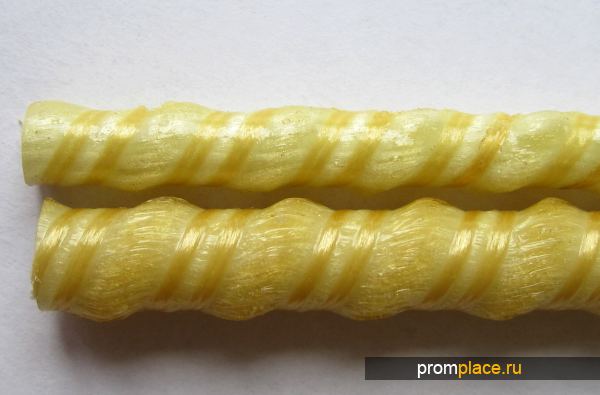
This condition is well controlled, as it is important that the diameter of the strand stretched is within strict tolerances when winding the yarns on the high-speed spool (winding takes place at a speed of several thousand meters per minute). Such a thread is created for the subsequent manufacture of reinforcing materials in various ways, corresponding to technical and technological developments and requirements.
Fiberglass reinforcement has become a fundamentally new solution to reduce the cost of construction work. The price for it is formed depending on the outer diameter. At the present time, with a deep and reasoned approach to the choice of building materials, cost is a significant indicator. With fiberglass, cost savings and quality retention are evident.
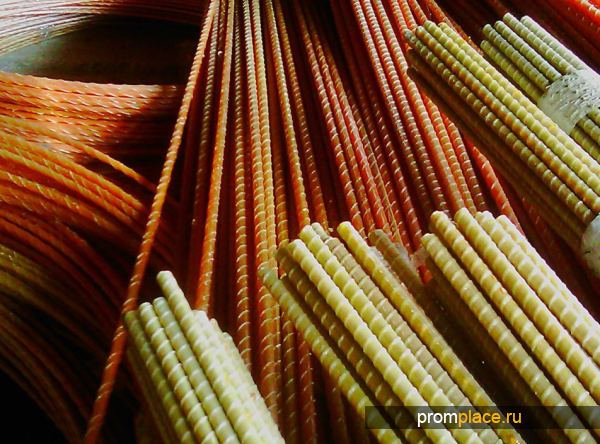
The manufacturing capabilities of the manufacturer shape the quality of the fiberglass structures. It is possible to buy fittings with sufficiently high properties and guaranteed reliability, having previously studied the factory characteristics and taking into account the feedback from construction clients in the process. The leading parameter in the selection should be the reliability of the supplier.
Purpose of products
Fiberglass reinforcement is also used to form the foundation. It is the basis of the entire building, therefore only careful design will lead to the durability and strength of the building. Reviews of this building material have a positive trend. The craftsmen take into account the increased strength at a small diameter in comparison with the calculations for metal reinforcement.
At the same time, the CA itself is much lighter, which requires a thorough general recalculation, and not just a comparison of the price per kilogram. Construction professionals should consider the thickness of the reinforcement as one of the important metrics. Fastening together, the fibers create the necessary frame, which should then be poured with concrete to form a monolith.
The foundation is of several types: tape, columnar and monolithic. For the construction of wooden and brick houses (with the possibility of creating a basement), tape and monolithic are often used. Both types are created with a frame of the required amount of CA, poured with concrete. The service life of such a frame is longer than that of a metal-reinforced one. In addition, chemical resistance should be taken into account: it is not affected by additions to concrete for work at sub-zero temperatures.
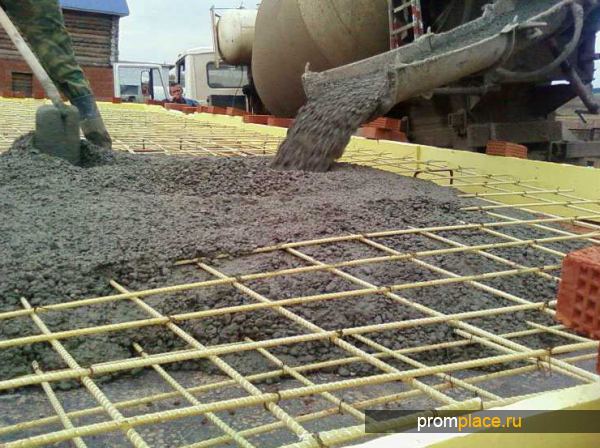
In general, these products have positive characteristics. Theoretical calculations involve the use of reinforcement structures immersed in water. This will not be reflected in the formation of corrosion. Its advantages are to withstand contrasting temperatures, resistance to moisture, chemical influences, which is especially important for harsh outdoor conditions.
It should be noted that in seismically active areas it is more expedient to use fiberglass. Aging of metal with vibration is faster, there is no so-called effect of breaking the reinforcement during an earthquake. Thus, CA belongs to reliable building materials.
One of the most important elements of any building is the foundation, and you cannot argue with this statement. After all, if the base is of poor quality, then this can lead not only to damage to the remaining elements of the building, but also to the rapid collapse of the structure as a whole.
Therefore, in order to strengthen the base of buildings, a specially designed type of building materials should be used - reinforcement for the foundation.
Modern foundation fittings
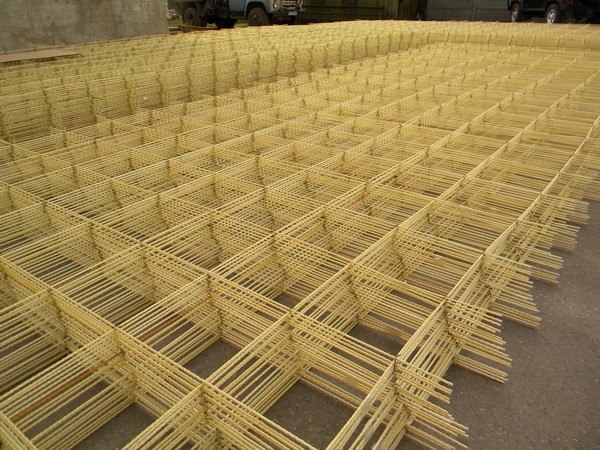
Today, there are new trends in the building materials market. Progress does not stand still, and therefore new, more technologically advanced materials are replacing traditional materials. This also applies to reinforcement, because steel, which for many years was the only material for its manufacture, is slowly but surely being forced out of the market by fiberglass, which has a number of serious advantages.
Rebar types
A wide variety of reinforcing bars are classified based on material, function and diameter.
However, regardless of these parameters, two types of fittings are distinguished:
- Working. It includes such classes as ASh, A400, A500, etc. The main purpose of such rods is to absorb various tensile loads. Working in bending, such elements prevent the foundation concrete from reaching the critical tensile point in the stress zone. The working rods have a periodic profile, which provides the products with maximum strength, as well as the ability to reliably set with concrete mortar due to the increased surface area.
- Mounting, includes classes AI or A240.
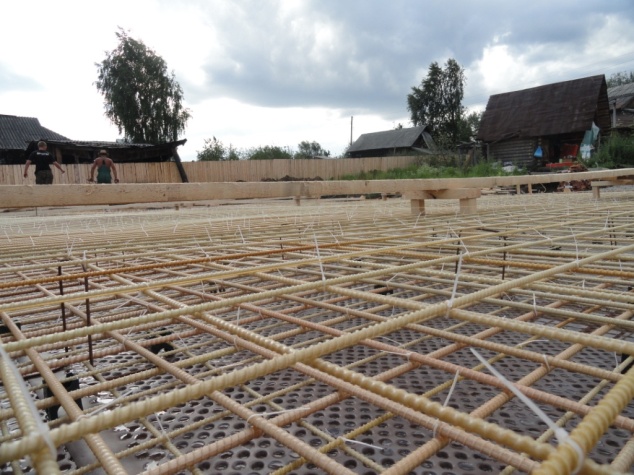
The main purpose of the material is to form a spatial frame. In most cases, such rods have a smooth surface and a small diameter, which is quite enough to be used as supporting elements for meshes or a frame when pouring a foundation.
The diameter of the bars should be selected depending on the reinforcement calculations and the type of base. However, the most popular are mounting rods, with a diameter of 6 to 10 mm, workers - from 10 to 16 mm.
Any composition that is distinguished by bending resistance can be used as a material for such products. And the highest requirements are met by hydroglass for the foundation.
About Composite Reinforcement Bars
Composite materials have become available for production thanks to the development of nanotechnology. They are distinguished by amazing properties that are not characteristic of materials of natural origin, because these qualities are explained not so much by the composition of the substance as by its molecular structure.
Fiberglass foundation reinforcement is used in the construction of the foundation frame, available in various sizes and diameters.
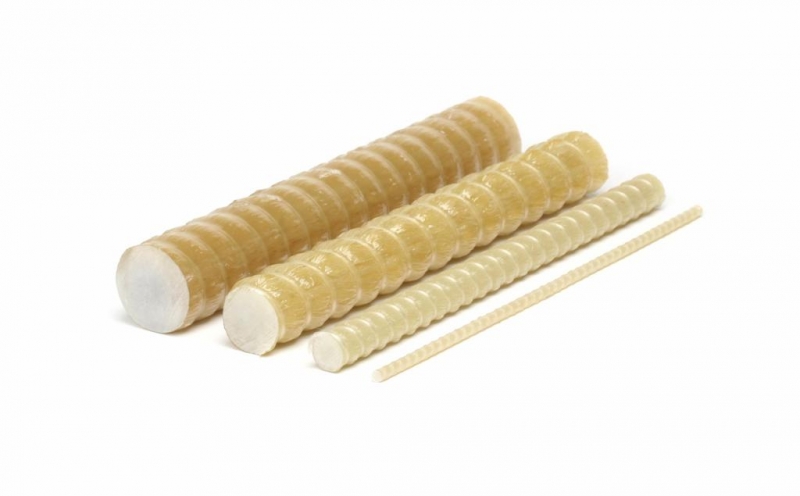
Advice! Unlike steel, fiberglass stretches during bending, therefore, in some cases, it is advisable to use such material only when the plastic reinforcement is pre-stretched to values \u200b\u200bclose to the limit.
Let's consider the most important advantages of fiberglass rods:
- High reliability. Such a material is capable of withstanding loads that are several times higher than the tensile strength of a steel rod of similar thickness. In this way, you can reduce the consumption of foundation material by using a sparser mesh.
The use of fiberglass products is advantageous when the strength of the metal rods is insufficient to strengthen the structure and the reinforcement needs to be strapped with additional reinforcing elements. In this case, it is possible to avoid additional material consumption by using fiberglass rods.
- Durability. Located in a monolithic foundation, such rods are in constant contact with an aggressive concrete environment. This has an extremely negative effect on the structure of the metal, as a result of which it is quickly eaten away by corrosion. As a result, the strength of the building is lost over time.
Fiberglass, in turn, is chemically absolutely inert, and the guaranteed service life of such elements is 200 years.
- Ease. Such reinforcement weighs 4 times less than similar steel. If we take into account the amount of reinforcement on the foundation of a large building, then it should be noted that when using fiberglass rods, the weight of the structure is reduced by several tons, and besides technical characteristics, due to the low weight, the cost of construction work is also reduced.
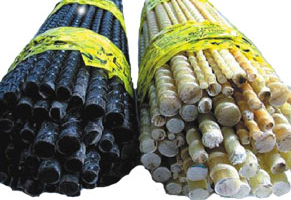
How does the cost of construction depend on the weight of the rods? If you take into account the transportation and operation of the crane, then the benefits will be obvious. In addition, the light weight allows you to easily do all the work with the reinforcing frame with your own hands.
- Low thermal conductivity. The fact is that significant heat losses occur precisely through the metal rods of the foundation. And if you want to produce high-quality thermal insulation of the building, then in this case all the nuances should be taken into account. Plastic rods can reduce heat loss by 100 times in comparison with metal ones.
- Low cost. The point is not only that the price of fiberglass rods is lower than metal ones. The savings also lie in the fact that due to the high strength of such products, you can use rods of a smaller diameter for the foundation.
Advice! There are many materials on the market today that are not of adequate quality. Real fiberglass fittings are produced at those enterprises that have their own scientific laboratories, so before buying, make sure that the manufacturer has the necessary production base.
Reinforcing frame creation
Instructions:
- We lay the required number of transverse rods using smooth reinforcement (diameter 6-8 mm).
- We put two longitudinal rods on the transverse rods (ribbed reinforcement, diameter from 12 to 16 mm). This will be the bottom chord of the frame.
- In the places where the transverse rods meet the longitudinal ones, we mount vertically smooth reinforcement, with a length of 100 mm less than the height of the tape.
- We tie the crossbars to the vertical rods, as in the first step.
- On the upper transverse rods, a working longitudinal reinforcement should be laid (two rods, as in the second step), which will constitute the upper belt of the frame. Tie each connection carefully with wire.
Conclusion
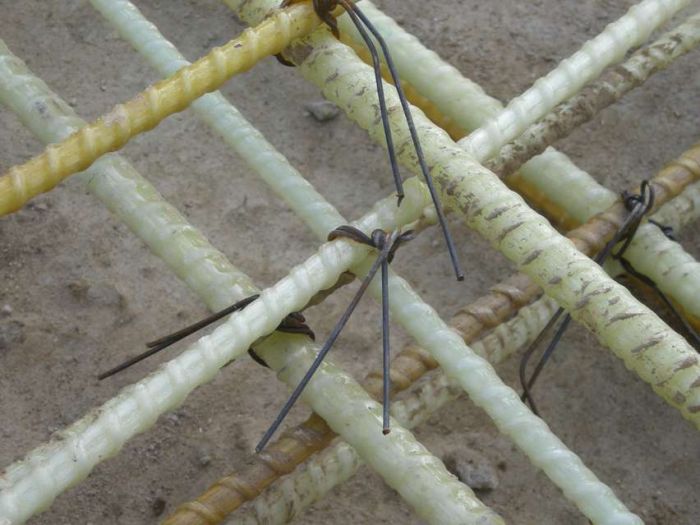
In the video presented in this article, you will find additional information on this topic.
Reinforcement is an integral process of creating reinforced concrete structures or products. In some cases, steel is contraindicated, therefore, in the middle of the last century, a replacement was developed - composite reinforcement.
Concrete is a durable but completely non-plastic material. It resists compressive loads excellently and cannot withstand tensile stress. Therefore, an improperly formed foundation begins to quickly crack, crumble, and requires restoration work. To strengthen and strengthen the structure, a skeleton made of reinforcing rods is used, which evenly distributes loads and increases the service life of the skeleton.
Fiberglass composite reinforcement for the foundation is made from a mixture of:
1.reinforcing component - glass staple fiber, which takes on mechanical stress;
2. Polymeric binders providing good adhesion to concrete, uniform pressure distribution and protection from the external aggressive environment. Most often it is a multicomponent epoxy resin with special additives, hardeners and accelerators.
The ratio of the elements of the composite is approximately 75:25. There are practically no uniform standards for the production and use of this type of product, as well as therefore each company develops its own recipe and recommendations on how best to calculate the minimum required amount of fiberglass for a foundation, walls, columns, slabs, and so on.
There are 2 types of fiberglass fittings available:
- A periodic profile resembling a spiral winding. Achieved by winding a fiberglass rod onto the main rod. From above, the product is covered with a layer of binder, which protects the reinforcing component from external influences.
- Conditionally smooth. The surface is sprinkled with fine-grained sand, which promotes better adhesion of the material to concrete or other type of mortar. The cost of this type of product is about 15-18% higher than the corrugated analogue.
The fittings are produced in rods with a diameter of 4-18 mm. It can be bought packaged in bays of 50-100 linear meters or rods 6 m long.

The scheme of forming a spatial frame is similar to a metal one. The challenge is to reinforce the foundation, floor or slab in the most vulnerable areas. Therefore, the horizontal rows are located closer to the surface with a minimum spacing of up to 50 cm between them, and the transverse distribution and vertical support elements are installed in the form of a frame with a step of 30-80 cm.
The use of reinforcement is not limited to support structures such as foundations, columns, power transmission towers, lighting, and the like. Fiberglass is used:
- For the construction of septic tanks, roads, sidewalks.
- In the manufacture of fittings.
- When forming industrial floors, flooring, fences, bridge structures.
- When erecting multi-layer brickwork or monolithic walls, partitions, floors.
Fiberglass products are used even in the construction of log houses from rounded or debarked logs. The fact is that with some mistakes (damp wood, a change in design without agreement with the architect) in places of greatest stress, the structure begins to sag or bend. The use of metal products indoors is undesirable, therefore composite reinforcement comes to the rescue.

Pros and cons of fiberglass
The weight of composite reinforcing products is almost 4 times less than a steel analog. The foundation will weigh significantly less, which means that the load on the ground will decrease. In addition, the fittings have the following advantages:
1. Almost complete inertness to aggressive media, including alkali produced by concrete, solvents, sea water and the like. Due to this property, fiberglass can be used in the construction of barriers for hydroelectric power plants, piers, breakwaters and other facilities.
2. Complete radio transparency and absolute inertness to magnetic fields. Composite reinforcement is perfect for the construction of buildings (foundations, walls and ceilings) in which laboratories, special premises, etc. are supposed to be located.
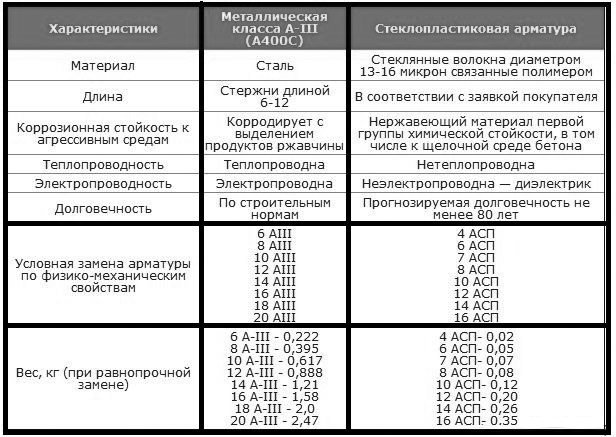
- Laying a reinforcing belt
- Required inventory
For a strong and reliable building, its base is constructed - the foundation. One of the simple in its construction and inexpensive execution is the strip foundation. It is designed to withstand stress and strain only when amplified. For these purposes, reinforcement is used, it compensates for the loads exerted, and the foundation remains intact even with severe deformations.
Fiberglass fittings are produced for cottages, baths or mansions.
Fiberglass rods are fiberglass profiles with transverse ridges and a round diameter. The protrusions are necessary for better adhesion of the rods and concrete.
New technologies to help builders
It is now becoming very fashionable to build buildings with modern technologies, so fiberglass is replacing the metal frame. As with the use of a conventional frame, and with the use of fiberglass, several types are distinguished. For screed frame, it is advisable to use knitting wire or plastic ties. During work, such devices are easier to work with, they do not lend themselves to rust and can withstand significant temperature changes.
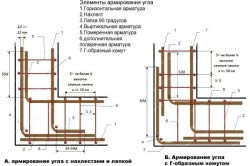
The first rule when assembling a fiberglass frame is to maintain the correct geometry, consistency during pouring and its strength. If the reinforcement strip foundation metal reinforcement is carried out with an interval of 10 to 20 cm and it depends on the depth of the foundation, then reinforcement of the strip foundation with fiberglass reinforcement is carried out every 20-23 cm.According to all building codes, reinforcement of at least 12 mm should be used for such purposes, but for foundations, which do not carry heavy loads, 6-8 mm is also suitable.
Assembling the frame from composite rebar also has its own nuances: there are devices with which the bends of all the necessary parts of the reinforcement and its fastening are made. For private construction, it is unprofitable to purchase such devices, but if the work is done often (the team specializes in performing construction work), then the availability of such a tool will significantly reduce labor costs and significantly save time for assembling the frame for the strip foundation.
For the device of the reinforcing belt of the strip foundation, two diameters of fiberglass reinforcement are used: the longitudinal parts of the frame are assembled from one, the second for transverse and vertical risers.
Back to the table of contents
Laying a reinforcing belt
After the excavation or trench, reinforcement is laid out and fixed in place of the strip foundation. The distance and diameter are calculated by the architects, and it is necessary to comply with the construction project of the building, since with strict observance of the construction technology, the building will stand for a long time. The diameter can also differ significantly when building foundations of different design.
After assembling the frame, the formwork is installed and the concrete is poured. At such an important stage, it is very important to anchor the reinforcement. What it is? Anchoring is a method of anchoring the tip of the rods. You can fix it in several ways:
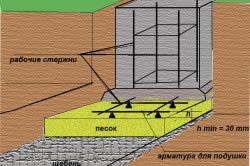
- bending of the reinforcement at the end;
- fixing the anchor bolt to the edges of the rods, it will hold the load in the nearby area.
Laying of fiberglass reinforcement is carried out in compliance with the same technologies as metal. A frame is assembled with two belts, upper and lower, the transverse rods are attached at equal intervals, but with a large step. The lower belt should be raised above the ground (fixed on a vertical riser or lifted on identical stones), the top of the protective layer of concrete may not be 5 cm, but 2.5 cm.Folds at the edges and corners should occur evenly, the length of the bent rod should not be less 25-30 cm.
When choosing fiberglass reinforcement, you should pay attention to the fact that it is produced in two types:
- Smooth.
- Ribbed.
In order to carry out the reinforcement, it is necessary to choose only ribbed, its indicators for pulling out of concrete are much better.
Back to the table of contents
The positive properties of fiberglass
The fiberglass material allows it to be used even under particularly harsh conditions:
- temperature differences (negative and high);
- constant exposure to moisture, which does not reduce its properties over time, corrosion does not occur;
- aggressive conditions and chemical attack.
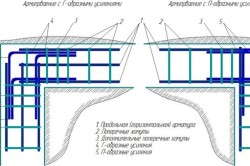
Taking into account all the properties, reinforcement of the strip foundation with fiberglass reinforcement is very often carried out. At this stage, it is important to remember that the composite material is much lighter than metal and stronger, therefore, its consumption will be less. Due to the declared strength, you can take 2 times less material, and the quality of the frame and foundation will not suffer from this.
The use of composite reinforcement allows you to save a considerable part of your money. The cost for such material is much less than for metal. This is primarily due to the consumption of material: delivery to the site of a smaller quantity will be cheaper. In the case of working with a fiberglass reinforcing component, labor costs and time for assembling and cutting the material are reduced. A grinder is used for work.
In this article, you will learn:
Let's try to figure it out and determine where the use of fiberglass reinforcement is justified and where it is not.
By itself, fiberglass reinforcement is a fiberglass rod, with a thread wound around it in a spiral form, for good adhesion to concrete. Its use is justified in many cases, but it is highly discouraged in some designs.
Now let's look at everything in order - first we will consider the advantages and disadvantages of fiberglass reinforcement, and then, based on them, we will determine where its use will be appropriate. At the end of the article, I will tell you about my personal opinion about use of fiberglass reinforcement.
Like any building material, fiberglass reinforcement has its own advantages and disadvantages compared to similar metal ones, which can become a serious help or hindrance in its use in different areas construction.
Let's probably start with the merits:
Advantages of fiberglass reinforcement
1. Low specific gravity... This advantage allows it to be used in lightweight structures, such as, for example, aerated concrete, etc. This property of fiberglass reinforcement allows to reduce the weight of the entire structure.
It is worth noting that the use of fiberglass reinforcement in ordinary concrete will not significantly affect the mass of the structure, given that the bulk of the weight will be given by the concrete itself.
2. Low thermal conductivity... As you know, fiberglass conducts heat through itself much worse than metal.
This advantage of fiberglass reinforcement allows it to be used where it is necessary to reduce cold bridges, which are so remarkably created by steel reinforcement.
3. Coil packaging... For the construction of private houses, this is a very significant advantage of fiberglass reinforcement, because you can not spend money on its delivery to the site, but, as you know, when building a house, especially if you build it yourself, every penny counts.
In addition to the above, it can be added that the use of fiberglass reinforcement in coils reduces its consumption, since there will be practically no overlaps in the reinforcement cage, and this will also slightly reduce financial costs.
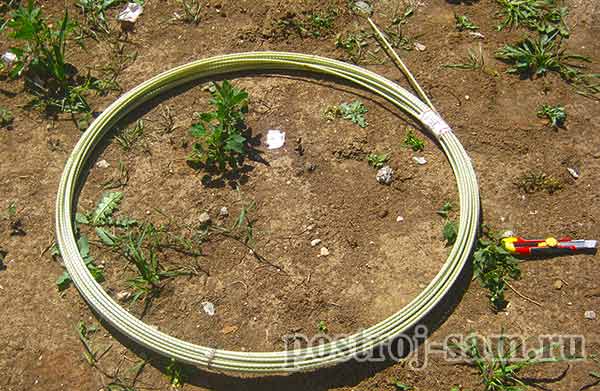 4. Durability... Manufacturers rely on the fact that fiberglass is much more durable than metal.
4. Durability... Manufacturers rely on the fact that fiberglass is much more durable than metal.
This is a slightly dubious advantage of fiberglass reinforcement, given that the metal inside the concrete is practically not susceptible to corrosion and inside the reinforced concrete structure will also last a very long time.
5. Dielectric... This property, most likely, in private construction does not give any advantages of fiberglass reinforcement over metal, but you should not forget about it either.
6. Chemical resistance... This means that in acidic and other aggressive chemical environments, fiberglass reinforcement is much more comfortable than steel.
In low-rise private construction, this advantage of fiberglass, like the previous one, practically does not play any role, except for construction in winter, when various salts are added to the solution or concrete, which adversely affect the metal.
7. Radio transparency... This means that the fiberglass reinforcement does not create any radio interference, unlike the metal circuits created by the steel reinforcement.
Such an advantage of fiberglass reinforcement as radio transparency will play a significant role only if there are a lot of reinforcement in the walls of your house. Then the use of fiberglass reinforcement will reduce radio interference inside the house.
We figured out the advantages, now let's look at the disadvantages of fiberglass reinforcement used in construction.
Disadvantages of fiberglass reinforcement
Any material has drawbacks and fiberglass reinforcement is no exception.
1. Fiberglass reinforcement more expensive ordinary steel if we compare the reinforcement of the same diameter.
A slightly dubious drawback, since manufacturers claim that fiberglass reinforcement is used in construction with a smaller diameter than metal.

2. Not thermally stable... Fiberglass reinforcement cannot withstand high temperatures.
It is also a dubious drawback, because in low-rise private construction, I cannot even imagine a situation where it will be necessary to heat the reinforcement to 200 degrees.
3. Does not bend... Thus, if we need, for example, to bend the reinforcement at an angle of 90 degrees, we cannot do this. Although on the other hand, we can make all the bends from ordinary steel and build them up with fiberglass.
4. Low modulus of elasticity at fracture... This means that fiberglass reinforcement cannot withstand the same fracture loads as metal reinforcement.
Many manufacturers claim the opposite - that the modulus of elasticity of fiberglass reinforcement is greater, but this, most likely, they mean tension, and concrete, as a rule, is subject to more stress on fracture. This is the main drawback due to which the use of fiberglass reinforcement in construction is limited.
5. Difficulty in constructing a rigid reinforcement cage... In other words, the frame made of fiberglass reinforcement is not as rigid as that of metal, and, accordingly, is less resistant to vibration and loads that will be present when pouring concrete from a car mixer.
When you pour concrete into a trench or formwork from an automatic mixer, it is necessary that the reinforcement cage is very rigid, because the reinforcement can "jump off" or simply press against the floor or walls of the trench, and it will be difficult to fix it when the concrete is already poured.
So we have considered almost all the main advantages and disadvantages of fiberglass reinforcement. Judging by them, it is impossible to say with great certainty that it is much better or worse than metal reinforcement, so let's consider in which building structures and structures the use of fiberglass reinforcement will be justified and expedient.
The use of fiberglass reinforcement in construction
The use of fiberglass reinforcement is justified in some cases both in industrial construction and in private low-rise construction.
Regarding industrial construction, I think it's not worth talking much, nevertheless, the site is devoted to the construction of houses with your own hands, so let's analyze the scope of use of fiberglass reinforcement in private low-rise construction.
1. Fiberglass reinforcement is used in some types of foundations, such as strip - buried below the freezing depth, slab foundation.
It should be noted that this only applies to low-rise private buildings, on good soil. On floating soils, there will be increased fracture loads, which fiberglass reinforcement may not withstand.
2. It is advisable to use fiberglass reinforcement in reinforcement brick walls, walls from blocks, very often you can find the reinforcement of walls from gas silicate blocks with fiberglass reinforcement.

The use of fiberglass reinforcement in wall reinforcement is very popular among developers. Moreover, such reinforcement is used as an element of reinforcement of the walls themselves, and as a bundle of the facing wall with the bearing.
3. In multi-layer panels as links. Since there is usually a dense insulation inside the panels, fiberglass reinforcement is used to bond the concrete parts together.
4. Justified the use of fiberglass reinforcement in the bearing parts of elements subject to increased corrosion, swimming pools, for example.
Metal reinforcement will corrode when concrete is in water, and fiberglass reinforcement is devoid of such a disadvantage, based on one of its advantages.
5. Also, fiberglass reinforcement is widely used in the reinforcement of glued wooden beams, increasing their rigidity.
6. Reinforcement of asphalt, in places of increased loads, although I have never seen this before.
As you can see, the scope of application of fiberglass reinforcement in construction is quite wide, although there are some limitations.
Author's opinion on the use of fiberglass reinforcement in construction
I believe that fiberglass reinforcement is not yet capable of completely replacing metal, but this does not mean that it can be completely neglected.
I widely use it in the construction of block and brick walls, also as connections of a facing wall with a load-bearing wall, since when using metal as ties, firstly, it will corrode, and secondly, the metal creates cold bridges, which are extremely undesirable in modern construction.
The use of fiberglass reinforcement in the foundation is also justified if you have a light structure, for example, a frame house or a garage.
If, on the site, there is weak soil and huge loads on the foundation are foreseen, I would not risk using reinforcement, whose fracture elasticity is less than that of metal.
